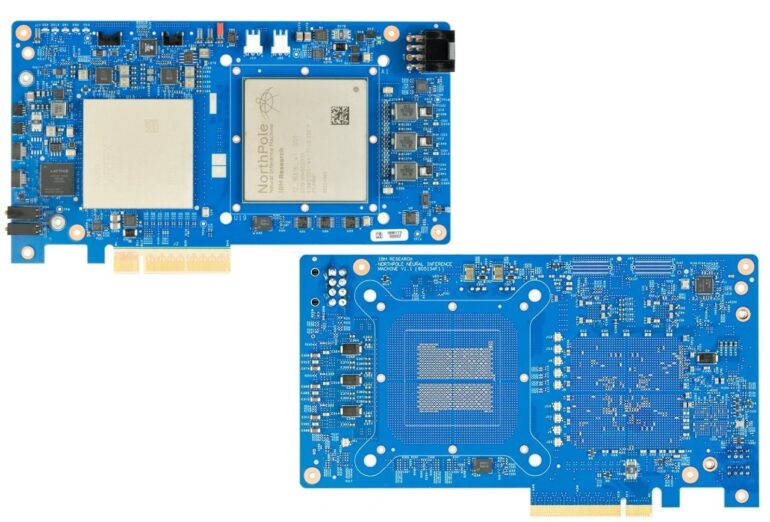TL;DR:
- IBM Research has developed the NorthPole chip, delivering AI-based image recognition speeds 22 times faster than current market chips.
- The chip’s innovative architecture, inspired by the human brain, combines processing and data, resulting in unprecedented efficiency.
- NorthPole’s all-digital design allows seamless communication between computing cores and memory blocks, enabling rapid data processing.
- Comparative tests against other market chips, including NVIDIA GPUs, showcased NorthPole’s remarkable performance advantage.
- Limitations include NorthPole’s specialization in AI processes, excluding training and handling large language models.
- Future plans involve connecting multiple NorthPole chips to overcome these limitations.
Main AI News:
In the realm of cutting-edge technology, IBM’s groundbreaking NorthPole chip has emerged as a game-changer. This dedicated computer chip, meticulously crafted by a cadre of computer scientists and engineers at IBM Research, has shattered the barriers of AI-based image recognition speed. Its performance eclipses existing chips on the market, surging ahead at an astonishing 22 times the pace.
In a meticulous exposition published in the esteemed journal Science, the IBM team meticulously delineates the genesis, mechanics, and remarkable prowess of their brainchild. Complementing their discourse, Subramanian Iyer and Vwani Roychowdhury, distinguished scholars from the University of California, Los Angeles, present a Perspective piece in the same journal, dissecting the profundity of the Californian team’s work.
The rapid proliferation of AI-powered applications has triggered an imperative quest for enhancement. Iyer and Roychowdhury cogently argue that progress lies in migrating towards an “edge” computer system, one that cohabitates data in close physical proximity to the AI applications harnessing it. Take, for instance, ChatGPT, a widely used commercial application reliant on internet-accessible data, which inevitably introduces undesirable time lags.
In response to this challenge, the IBM research team has masterminded a novel solution—a computer chip christened “NorthPole.” Drawing inspiration from the intricate workings of the human brain, NorthPole ingeniously amalgamates the processing module with its data source. The chip’s two-dimensional array of memory blocks, coupled with interconnected CPUs, constitutes its core architecture. Remarkably, its all-digital design empowers the computing cores to seamlessly communicate with both proximate and distant blocks, facilitating lightning-fast data processing and response times.
To empirically validate NorthPole’s mettle, the research team subjected it to rigorous testing alongside several incumbent market contenders, including NVIDIA GPUs. The results were nothing short of astounding—NorthPole outpaced its rivals by completing tasks at a staggering 22 times their speed. Notably, it also exhibited superior transistor speeds, cementing its position as a pioneer in AI acceleration.
However, it is essential to acknowledge a caveat in this breakthrough. NorthPole is currently restricted to running specialized AI processes, precluding its involvement in training processes or managing large language models such as ChatGPT. Nonetheless, the researchers harbor optimism for the future, as they set their sights on connecting multiple NorthPole chips. This strategic move, they believe, will surmount the chip’s existing limitations, further propelling the realm of AI innovation into uncharted territory.
Conclusion:
IBM’s NorthPole chip represents a seismic shift in the AI industry by substantially accelerating image recognition. Its innovative design and unmatched speed give IBM a significant competitive edge. As the AI landscape evolves, this breakthrough sets a new standard, emphasizing the importance of specialized hardware in AI optimization and spurring further advancements in the market.

